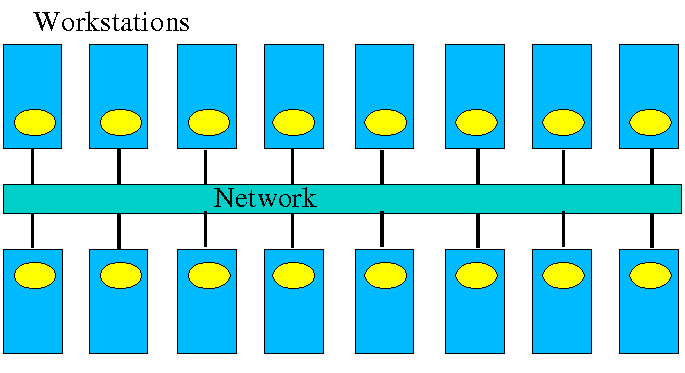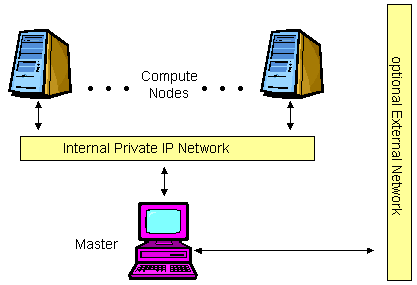Scyld ClusterWare Overview
Scyld ClusterWare is a Linux-based high-performance computing system. It solves many of the problems long associated with Linux Beowulf-class cluster computing, while simultaneously reducing the costs of system installation, administration, and maintenance. With Scyld ClusterWare, the cluster is presented to the user as a single, large-scale parallel computer.
This chapter presents a high-level overview of Scyld ClusterWare. It begins with a brief history of Beowulf clusters, and discusses the differences between the first-generation Beowulf clusters and a Scyld cluster. A high-level technical summary of Scyld ClusterWare is then presented, covering the top-level features and major software components of Scyld. Finally, typical applications of Scyld ClusterWare are discussed.
Additional details are provided throughout the Scyld ClusterWare HPC documentation set.
What Is a Beowulf Cluster?
The term "Beowulf" refers to a multi-computer architecture designed for executing parallel computations. A "Beowulf cluster" is a parallel computer system conforming to the Beowulf architecture, which consists of a collection of commodity off-the-shelf computers (COTS) (referred to as "nodes"), connected via a private network running an open-source operating system. Each node, typically running Linux, has its own processor(s), memory storage, and I/O interfaces. The nodes communicate with each other through a private network, such as Ethernet or Infiniband, using standard network adapters. The nodes usually do not contain any custom hardware components, and are trivially reproducible.
One of these nodes, designated as the "master node", is usually attached to both the private and public networks, and is the cluster's administration console. The remaining nodes are commonly referred to as "compute nodes". The master node is responsible for controlling the entire cluster and for serving parallel jobs and their required files to the compute nodes. In most cases, the compute nodes are configured and controlled by the master node. Typically, the compute nodes require neither keyboards nor monitors; they are accessed solely through the master node. From the viewpoint of the master node, the compute nodes are simply additional processor and memory resources.
In conclusion, Beowulf is a technology of networking Linux computers together to create a parallel, virtual supercomputer. The collection as a whole is known as a "Beowulf cluster". While early Linux-based Beowulf clusters provided a cost-effective hardware alternative to the supercomputers of the day, allowing users to execute high-performance computing applications, the original software implementations were not without their problems. Scyld ClusterWare addresses — and solves — many of these problems.
A Brief History of the Beowulf
Cluster computer architectures have a long history. The early network-of-workstations (NOW) architecture used a group of standalone processors connected through a typical office network, their idle cycles harnessed by a small piece of special software, as shown below.
The NOW concept evolved to the Pile-of-PCs architecture, with one master PC connected to the public network and the remaining PCs in the cluster connected to each other, and the master, through a private network as shown in the following figure. Over time, this concept solidified into the Beowulf architecture.
For a cluster to be properly termed a "Beowulf", it must adhere to the "Beowulf philosophy", which requires:
Scalable performance
The use of commodity off-the-shelf (COTS) hardware
The use of an open-source operating system, typically Linux
Use of commodity hardware allows Beowulf clusters to take advantage of the economies of scale in the larger computing markets. In this way, Beowulf clusters can always take advantage of the fastest processors developed for high-end workstations, the fastest networks developed for backbone network providers, and so on. The progress of Beowulf clustering technology is not governed by any one company's development decisions, resources, or schedule.
First-Generation Beowulf Clusters
The original Beowulf software environments were implemented as downloadable add-ons to commercially-available Linux distributions. These distributions included all of the software needed for a networked workstation: the kernel, various utilities, and many add-on packages. The downloadable Beowulf add-ons included several programming environments and development libraries as individually-installable packages.
With this first-generation Beowulf scheme, every node in the cluster required a full Linux installation and was responsible for running its own copy of the kernel. This requirement created many administrative headaches for the maintainers of Beowulf-class clusters. For this reason, early Beowulf systems tended to be deployed by the software application developers themselves (and required detailed knowledge to install and use). Scyld ClusterWare reduces and/or eliminates these and other problems associated with the original Beowulf-class clusters.
Scyld ClusterWare: A New Generation of Beowulf
Scyld ClusterWare streamlines the process of configuring, administering, running, and maintaining a Beowulf-class cluster computer. It was developed with the goal of providing the software infrastructure for commercial production cluster solutions.
Scyld ClusterWare was designed with the differences between master and compute nodes in mind; it runs only the appropriate software components on each compute node. Instead of having a collection of computers each running its own fully-installed operating system, Scyld creates one large distributed computer. The user of a Scyld cluster will never log into one of the compute nodes nor worry about which compute node is which. To the user, the master node is the computer, and the compute nodes appear merely as attached processors capable of providing computing resources.
With Scyld ClusterWare, the cluster appears to the user as a single computer. Specifically,
The compute nodes appear as attached processor and memory resources
All jobs start on the master node, and are migrated to the compute nodes at runtime
All compute nodes are managed and administered collectively via the master node
The Scyld ClusterWare architecture simplifies cluster setup and node integration, requires minimal system administration, provides tools for easy administration where necessary, and increases cluster reliability through seamless scalability. In addition to its technical advances, Scyld ClusterWare provides a standard, stable, commercially-supported platform for deploying advanced clustering systems. See the next section for a technical summary of Scyld ClusterWare.

